Fake Fiber: good for health...or selling junk?

Hayati Kayhan - stock.adobe.com.
"Very high in fiber," boasts the bag of Smart Sweets Gummy Bears, which have 100 percent of a day's worth of fiber in each serving. What does the fiber that's added to gummy bears do for you? Maybe nothing at all. Here's the scoop on which kinds of fiber do what.
"Introducing the sweet side of fiber," announces VitaFiber's online video.
The syrupy liquid is an IMO, "short for isomaltooligosaccharide, which is a natural soluble dietary fiber made from tapioca," says the website.
"IMO helps improve digestion, strengthens your immune system, improves mineral absorption, lowers cholesterol, helps with weight control, and reduces the risk of disease."
Really?
And it's not just IMO.
"Fiber fit for all," proclaims Fibersol's website. It offers companies "a full line of low-viscosity soluble dietary fiber ingredients made from cornstarch" that can be used "in a variety of food and beverage applications as well as in dietary supplements."
Variety is right. We're talking cakes, pastries, brownies, muffins, doughnuts, croissants, cookies, candy, chocolate centers, gummies, marshmallows, fudge, potato chips, trail mixes, energy bars, cereal bars, coffee whiteners, whipped toppings, gelato, and more, according to the website.
"Reach your desired fiber content/label claims with no effects on taste or viscosity," promises Fibersol, a joint venture that includes Archer Daniels Midland.
Fibersol shows up on labels as "soluble corn fiber," "resistant maltodextrin," or "maltodextrin."
It joins inulin, or chicory root extract (sold by Cargill and others), polydextrose (sold by DuPont and Tate & Lyle), and other processed "fibers" that companies add to food.
Yikes. Are cookies, cakes, and candy what experts have in mind when they encourage people to eat more fiber?
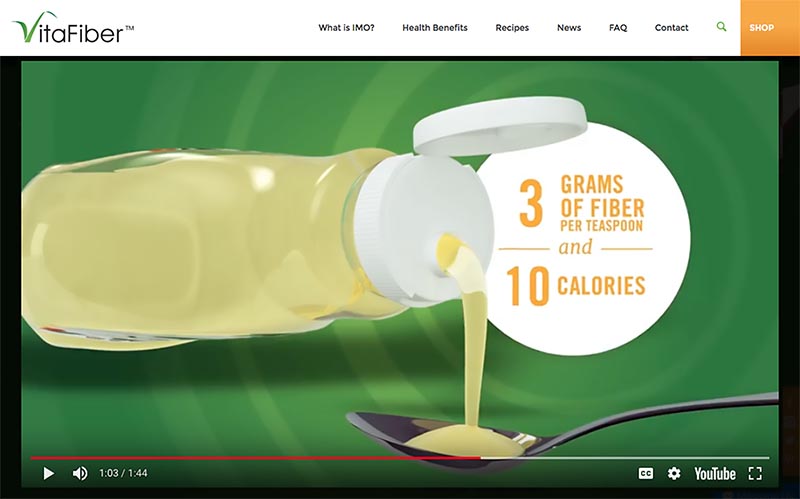
Fiber 101
What is fiber, anyway?
"It's a group of nondigestible carbohydrates that are not broken down in the upper gut—that is, in the stomach or small intestine," says Nicola McKeown, a scientist in the nutritional epidemiology program at the Jean Mayer USDA Human Nutrition Research Center on Aging at Tufts University.
In 2002, a National Academy of sciences report broke down fiber into:
■ intact fiber in fruits, vegetables, whole grains, and other plants, and
■ processed fibers that are extracted from plants or made in a lab, but only if they have a benefit for health.
But for now, any processed fiber can count as "fiber" on Nutrition Facts labels. That will change in 2020, when most foods must carry the new version of those labels.
By then, says the Food and Drug Administration, Nutrition Facts labels will only count a processed fiber if it curbs food intake or improves regularity, cholesterol, blood sugar, or the body's ability to absorb a mineral like calcium.
"We're in a gray area now because the FDA is reviewing the evidence that has been submitted by the manufacturers of these fibers," says McKeown.
So far, the FDA has approved cellulose for regularity and six fibers—beta-glucan, psyllium, guar gum, pectin, locust bean gum, and hydroxypropyl-methylcellulose—for lowering cholesterol levels.
"When the new labels are required, consumers can have confidence that any fiber that's listed on that label has a health benefit," notes McKeown. The catch: the label won't say which benefit.
Want to stay regular? The fiber in that energy bar might only help you absorb more calcium or other minerals.
Hoping to curb your appetite? The fiber in that breakfast shake may only help lower your cholesterol.
"They don't all do the same thing any more than vitamins and minerals all do the same thing," explains McKeown, who led a team that compiled a database of nearly 1,000 fiber studies.
That's not a problem with intact fiber.
"Fruits, vegetables, beans, and whole grains have a mixture of fibers," says McKeown. "So if you eat a plant-based diet, you're getting all of them."
(Click here for a chart that shows how much intact fiber is in some common foods.)
But processed fibers are a different story. "Some may have no health benefits at all," says McKeown. "Manufacturers add fibers for a variety of reasons, and that sometimes gives the food a health halo."
Which fibers do what?
"It depends on the physiological & characteristics of the fiber," says McKeown. That includes whether the fiber is:
■ soluble (it dissolves in water),
■ viscous (it thickens or forms a gel when water is added), or
■ fermentable (it's broken down by gut bacteria in the large intestine).
Many processed fibers are soluble, non-viscous, and fermentable. And that makes them the least likely to do much for your health.
Staying Regular
What's the best fiber to prevent constipation?
"For regularity, we look for fiber that increases stool mass and stool frequency," says McKeown. "If you're eating a diet that's rich in whole grains, legumes, fruits, and vegetables, that will contribute to an increase in stool bulk."
Two types of fiber fit the bill.1
"The first is insoluble fiber like wheat bran," explains McKeown. But not just any wheat bran. "In order for bran to be effective, it has to be relatively coarse," she notes.
"It's the coarseness that irritates the lining of the bowel, which stimulates water to be secreted. And it's this water that leads to the softening and bulking effect on stool."
When researchers had people swallow plastic particles that were cut to match the size and shape of coarse wheat bran particles, they boosted "output" like the wheat bran did. But small, smooth plastic particles did not.2
So if your whole-grain bread or cereal is made with finely ground bran, it may not do as much for your regularity as, say, bran flakes.
The second fiber with a laxative effect is "a soluble, gel-forming fiber, like psyllium, that is able to hold on to moisture in the large bowel and is not fermented," says McKeown.
Psyllium is the key ingredient in Metamucil. It's also added to Kellogg's Bran Buds cereal.
Why don't fermentable fibers help?
"As they're being fermented, they're broken down by the gut microbiota in the large intestine, so they don't contribute to stool mass," says McKeown.
"They don't have that stool-forming property."
Most added fibers—like inulin, polydextrose, and soluble corn fiber—are fermentable.
Eating Less
Which processed fibers help you feel so full that you eat less at the next meal (even though that might not matter enough to help you lose weight)? So far, none.
"Companies have been piggybacking on satiety claims for added fibers such as inulin for years," says Barbara Rolls, professor and the Helen A. Guthrie Chair of Nutritional Sciences at Penn State.
"But I don't know if they have the evidence to substantiate those claims."
In one study, Rolls fed people a 125-calorie "appetizer" of apple slices, applesauce (made from the same batch of apples), or apple juice either with or without enough added fiber to match the fiber in the apple slices and applesauce.3
"The apple slices were most satiating," says Rolls. People ate 190 fewer calories at their next meal after eating them, but only 100 fewer calories after the applesauce, and no fewer calories after either juice.
"What was it about the apples?" asks Rolls. "The chewing, the crunch, the cellular structure, the volume that comes from the intact cells and fiber—they can all have an impact on satiety."
It's not just the fiber in fruits and vegetables that makes them so filling.
"You can't assume that just dumping a powder into a food is as effective as eating fiber in its natural form," says Rolls.
Lowering Cholesterol
Want to lower your LDL ("bad") cholesterol? Look for soluble, gel-forming fibers like psyllium and beta-glucan (a fiber in oats and barley).1
"Both have FDA-approved health claims for reducing cardiovascular disease by lowering cholesterol," notes McKeown.
How do they work?
As the fiber moves down your intestine, it absorbs water from the partly digested food, making the entire mass thicker and more sludge-like. That traps bile acids.
"Our bodies are always making bile acids to break down the fat particles in food, so that they can be absorbed into the body," says McKeown.
"The thickening mass traps bile acids that would normally be reabsorbed, and then eliminates them through the stool." Once the bile acids are excreted, the body has to make more to replace them.
"The liver uses cholesterol to make bile acids, so there's less cholesterol available to be wrapped into LDL particles," explains McKeown. "That effectively lowers blood levels of LDL cholesterol."
Keeping a Lid on Blood Sugar
Looking to curb spikes in blood sugar?
"You're back to the soluble, gel-forming fibers like beta-glucan and psyllium," says McKeown.
"There doesn't appear to be any effect on blood glucose from fibers that are non-viscous and readily fermented—like inulin, resistant starches, and wheat dextrin, for example."
The soluble viscous fibers work by thickening the mush of food that travels down the intestine.
"If you're eating fiber such as beta-glucan, the mush becomes so thick, it slows down the absorption of nutrients and glucose," says McKeown.
"When we eat a meal, blood sugar increases. Having these types of fibers as part of the meal will blunt the rise in blood sugar. And that blunted response will require less insulin."
Digesting It All
Could processed fibers have other health benefits? For example, IMO is "a prebiotic, which nourishes the good bacteria already in your gut," says VitaFiber.
Are fermentable fibers good for you simply because they may boost good bacteria? No, says the FDA.
"However, research on fermentable fibers and the gut is ongoing," says McKeown. So stay tuned.
In the meantime, one result of all that fermenting is fairly reliable: more gas.
And keep in mind that experts set fiber targets based on studies of people who consume fiber-rich fruits, vegetables, whole grains, and beans, not gummy bears or cookies.
"Your first line of defense is to get adequate amounts of dietary fiber from a variety of plant foods," says McKeown.
References
1J. Acad. Nutr. Diet. 117: 251, 2017.
2Dig. Dis. Sci. 44: 744, 1999.
3Appetite 52: 416, 2009.
Gimme Gummies
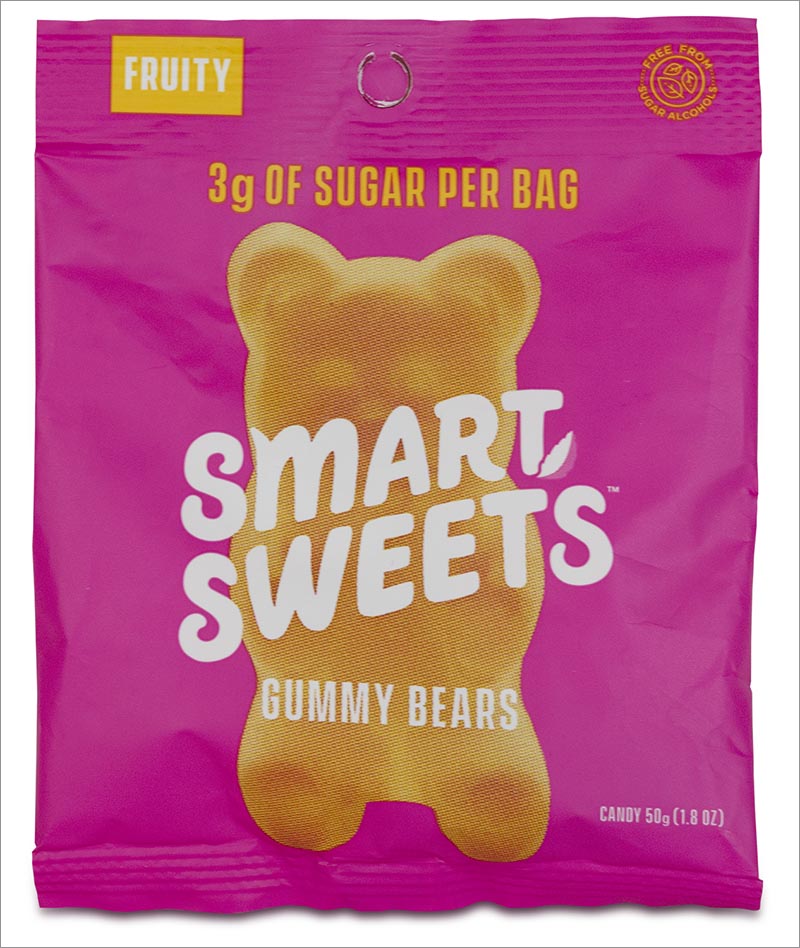
"Very high in fiber,” promise Smart Sweets Gummy Bears. “Very” is right. Each 90-calorie bag has 100 percent of a day’s fiber (28 grams). Wow.
Labels can say “good source of fiber” with just 2.5 grams per serving, and “high in fiber” with only 5 grams.
Why so much fiber in gummy bears? Their prime ingredient is “prebiotic soluble fiber from tapioca,” or isomaltooligosaccharides, aka IMO. (They also contain chicory root fiber.)
IMO’s manufacturers mostly cite three key studies as evidence that IMO improves regularity. Two—on a total of 20 constipated elderly nursing home residents in Taiwan who were put on a low-fiber diet—weren’t well controlled.1,2
And the largest (an unpublished industry study) found no increase in bowel movements in 61 people without constipation who were given 36 grams of IMO a day.3
“Kick sugar. Keep candy,” urges Smart Sweets. “3 g of sugar per bag.” (Its sweetness comes largely from stevia.) But blood sugar may be no lower after consuming IMO than after eating sugar.3 So it’s no freebie for people with diabetes or anyone who wants to keep a lid on their blood sugar.
References
1 J. Am. Coll. Nutr. 20: 44, 2001.
2 Nutrition 27: 445, 2011.
3 www.regulations.gov/document?D=FDA-2016-P-4275-0006.
Gas Generator?
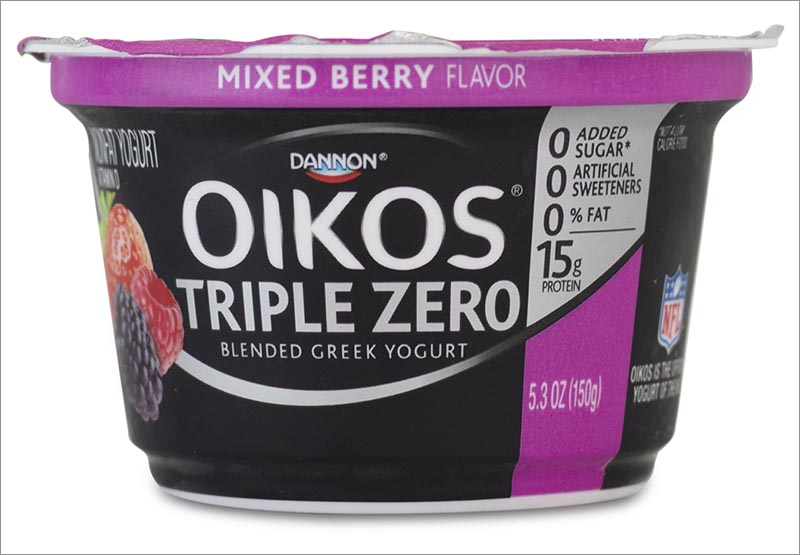
“High in fiber,” says Dannon Oikos Triple Zero greek yogurt.
Each tub has 6 grams of chicory root fiber (inulin), which improves the “mouthfeel” or creaminess of low-fat foods and may temper the taste of Triple Zero’s stevia.
Companies extract the inulin in chicory root using hot water. They can then use enzymes to break up inulin’s long chains of sugar units (saccharides) into shorter chains, called oligofructose. Or they can make really short-chain fructooligosaccharides not from inulin, but simply by treating sugars with enzymes.
What can inulin do? Most studies find no effect on blood sugar, LDL (“bad”) cholesterol, regularity, or food intake.1
However, a mix of inulin and oligofructose boosted calcium absorption and bone mineral density in a year-long study of adolescents.2 It’s not clear if short-chain fructooligosaccharides can do the same, and only a few small studies have looked at inulin or oligofructose and calcium absorption in adults.
A possible downside: If excess calcium increases prostate cancer, absorbing more is a minus. Another: In many studies, people given inulin report more gas.3
References
1 fda.gov/downloads/Food/LabelingNutrition/UCM529049.pdf.
2Am. J. Clin. Nutr. 82: 471, 2005.
3Food Funct. 2: 72, 2011.
Hedge Fudge
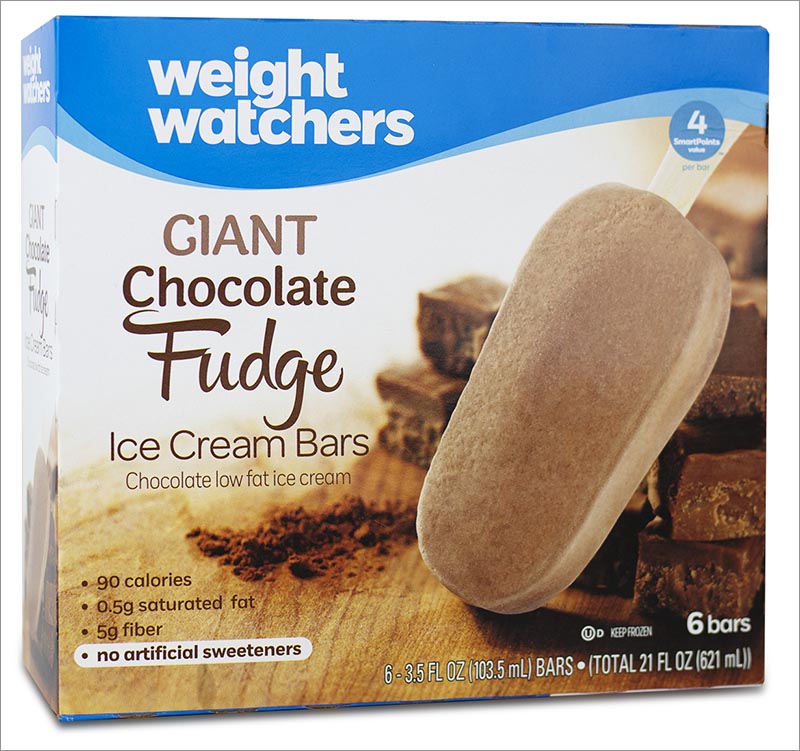
“5g fiber,” says the box of Weight Watchers Giant Chocolate Fudge Ice Cream Bars. “No artificial sweeteners.”
Yes, but the bars’ main fiber—polydextrose—is artificial. It’s made by chemically altering the bonds between sugars so that our digestive enzymes can’t break them down. They’re fermented by gut bacteria instead.
What can polydextrose do? Two companies—DuPont and Tate & Lyle—cite six studies as evidence that it leads people to eat less. But in one of the best of the six (funded by Tate & Lyle), people ate no less at lunch a few hours after they got 24 grams of polydextrose than after they got a placebo. 1 A more recent study, which was funded by DuPont, also came up empty. 2 Oops.
Polydextrose also has a laxative effect, say the companies. But the evidence is inconsistent. For example, about 20 grams a day led to no increase in stool frequency in one study and an increase from 4.4 to 5.5 stools over five days in another. 3,4 People in both studies reported more gas.
So much for justifying that fudge bar as your tummy aid or hedge against weight gain.
References
1Appetite 56: 9, 2011.
2Appetite 110: 15, 2017.
3Br. J. Nutr. 106: 1864, 2011.
4J. Nutr. 143: 473, 2013.
Goodbye, Guilt?
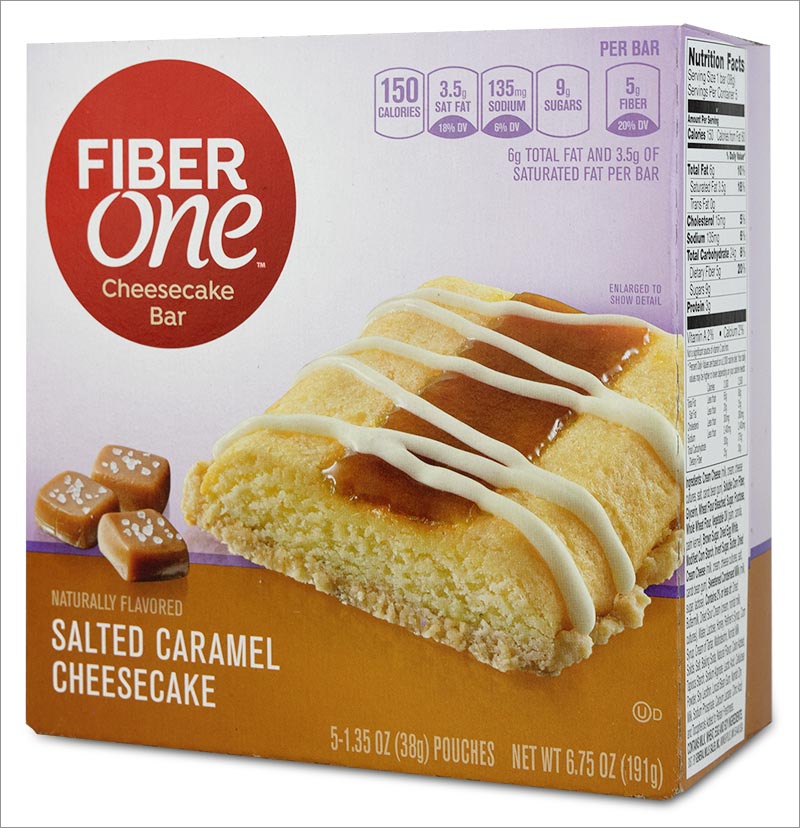
“5g of fiber so you can enjoy every bite,” says the Fiber One Salted Caramel Cheesecake Bar label.
Got that? The fiber is there to wash away the guilt of eating a 150-calorie cookie made largely of cream cheese, white flour, sugar, and soluble corn fiber (aka resistant maltodextrin).
Soluble corn fiber is produced by using heat to make some of the chemical bonds in cornstarch indigestible, and by using enzymes to remove the remaining digestible bonds.
What can soluble corn fiber do? In most good studies, it doesn’t lower blood sugar.1
However, doses of 10 to 20 grams a day increased calcium absorption or retention in three studies on a total of 52 adolescents and 12 postmenopausal women.2-4 Whether those studies are large and long enough to count as a health benefit is up to the FDA.
But absorbing more calcium may not be a plus for everyone (see “Gas Generator?”).
References
1J. Agric. Food Chem. 60: 11928, 2012.
2J. Nutr. 146: 1298, 2016.
3Am. J. Clin. Nutr. 104: 837, 2016.
4Br. J. Nutr. 112: 446, 2014.
Photos: Hayati Kayhan/stock.adobe.com (top), Jennifer Urban/CSPI (Smart Sweets, Oikos, Weight Watchers, Fiber One).

